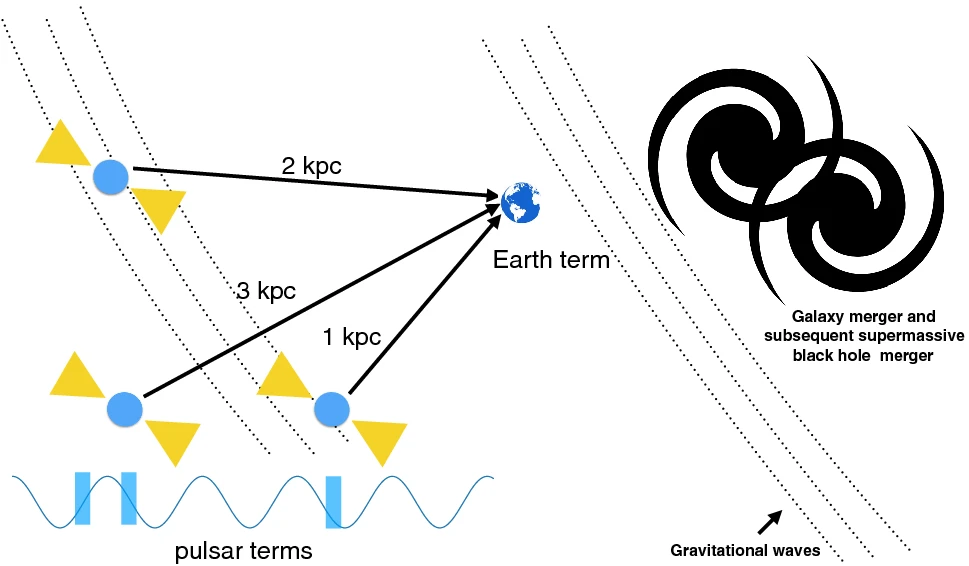Title: Efficient large-scale, targeted gravitational-wave probes of supermassive black-hole binaries
Authors: Maria Charisi, Stephen R. Taylor, Caitlin A. Witt, Jessie Runnoe
First-author institution: Department of Physics & Astronomy, Vanderbilt University, Nashville TN, USA
Status: Published in Physical Review Letters [closed access]
Since the publication of evidence for a nanohertz-frequency gravitational wave background (GWB), pulsar timing arrays (PTAs) are in vogue. They promise a new way to measure the faint whispers from astrophysical and cosmological sources, and resolve some issues in our current view of the universe. For example, if we assume that the GWB is the unresolved superposition of gravitational waves from a population of supermassive black hole binaries (SMBHB) inspiraling towards each other, some models suggest that these binaries will ‘stall’ and cannot merge within the age of the universe. However, from observations of galaxies, we know that most of them have single binaries at their centers. This inconsistency is called ‘the final parsec problem.’ While this problem can be resolved by introducing a triaxial dark matter halo, and allowing the binary to interact with the circumbinary gas disk and with stars at the center of the galaxy, the exact details of these interactions are unclear.
Ideally, we would like to combine gravitational wave (GW) observations from individual SMBHBs in PTA data with electromagnetic (EM) observations from traditional telescopes. This combination of GW and EM observations is an example of multi-messenger astronomy (MMA). Combining information from these two messengers should improve parameter estimation of the binary, allowing us to further understand the dynamics of the system and its sub-parsec physics. The problem is, if a PTA detects a single binary system in the future, localising that system in the sky will be difficult.
Currently, PTAs have poor sky resolution. Therefore, if a single binary is detected and a region of sky is determined to be its location, there are hundreds, if not thousands, of potential host galaxies for that source. Observing every single galaxy to check if it could be the source is not viable, and a faster technique to identify the host is required. A targeted GW analysis speeds-up searches by fixing the potential GW source in the analysis to a candidate from a galaxy catalogue, hence the sky location and distance to the source can be fixed instead of being allowed to vary during analyses.This speeds up computation by reducing the parameter space to be searched over. However, computation is still inefficient.

The problem is that each pulsar in the array is between a few kpc to 1000s of kpc’s away from Earth, which is longer than the typical GW (~kpc) that passes through them. As an SMBHB emits GW, it loses energy, causing the binary to get closer, which increases the frequency of GWs being emitted. Over time, the frequency of GWs being emitted by SMBHB increases. Therefore, the frequency of GWs from an SMBHB will be observed to be different at each pulsar and also at the Earth, because it takes time for GWs to travel across the array and the SMBHB will evolve over that time. That effect must be taken into account – there is an ‘Earth term’ (the effect of GWs as it passes the Earth, common to all pulsars-Earth ‘arms’) and a ‘Pulsar term’ (the effect of GWs as it passes by each pulsar, independent to each pulsar-Earth ‘arm’). The geometry of this problem is shown in Figure 1. A full analysis requires six parameters to describe the SMBHB model (the Earth term, which includes parameters such as the GW frequency of the binary and the total mass of the SMBHB), and two parameters per pulsar (the pulsar terms, which are the distance to the pulsar and the phase of the GW wave as it passes by that pulsar). The NANOGrav 12.5 year data set featured 45 pulsars, so a full analysis requires 96 parameters which is difficult to efficiently sample over.
In this paper, the authors investigate the effect of ignoring the pulsar terms and reducing the problem down to just six parameters. This significantly speed-up analysis. The question is, can they recover the parameters of the source by including only the Earth term and ignoring the pulsar term?
The answer is, yes, pretty much. They attempt to recover the characteristics of an SMBHB signal injected into simulations of a PTA data set by using the full analysis technique, and by ignoring the pulsar terms. They find that the error between the recovered and injected parameters were consistent between the full and simplified analyses for GW frequency and total mass of the system, as seen in the two leftmost windows of Figure 2. The Earth-term only search performed worse than the full analysis for the other four binary parameters as seen in the four other windows of Figure 2. However, the full analysis doesn’t perform particularly well anyway on these parameters. Additionally, Earth-term only search was 70 times more efficient than the full analysis. This feature makes the Earth-term only technique a useful tool to quickly search over many SMBHB candidates with PTA data and to identify which candidates need to be investigated further with the more expensive technique.
Future PTA data sets will be more sensitive to localisable GW sources, but also more difficult to analyse because of the increase in the number of pulsars being observed, and upcoming sky surveys such as the Roman Space Telescope will significantly increase the number of potential SMBHB candidates that could be detected by PTAs and must be searched over. With such a large scale-up of data, robust and fast methods like this one to identify the most likely candidates is imperative for future analyses of PTA data.

Edited by Karthik Yadavalli
Featured image: Burke-Spolaor et al. 2019




